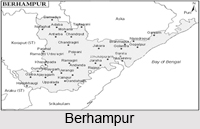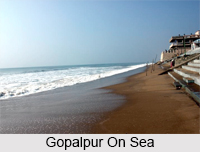 Berhampur is the popular city in Ganjam District of Odisha. This city is the gateway to enter in Gopalpur on sea, Chilka Lake, Barkul, Rambha and Taptapani. Berhampur is legendary and absolutely acknowledged for its exquisite silver filigree works and silk sarees woven with gold and silver threads. Hugely respected and held with much esteem, Berhampur can be termed as the most commercialised and urban centre for Odisha and of course for Ganjam district. Berhampur`s brass and bell metal ware, horn toys, wood carvings and carpets are worth a lifetime investment of home decor.
Berhampur is the popular city in Ganjam District of Odisha. This city is the gateway to enter in Gopalpur on sea, Chilka Lake, Barkul, Rambha and Taptapani. Berhampur is legendary and absolutely acknowledged for its exquisite silver filigree works and silk sarees woven with gold and silver threads. Hugely respected and held with much esteem, Berhampur can be termed as the most commercialised and urban centre for Odisha and of course for Ganjam district. Berhampur`s brass and bell metal ware, horn toys, wood carvings and carpets are worth a lifetime investment of home decor.
Location of Berhampur
Berhampur is situated at 19 degree and 20 minutes North Latitude 84 degree 50 East Longitude. Its average elevation above Mean Sea Level is 24.000 m. It is surrounded by vast cultivable plains.
History of Berhampur
Berhampur is environed by thick woods, dating to prehistoric times and once forming a part of territory under Emperor Ashoka`s reign. Going back to several eras in history and enriched in ancient content, Berhampur city`s Sanskrit name, Brahmapur, is still in use amongst the local populace. However, Brahmapur being the original Sanskrit name was lost to British linguistics and hence had been mercilessly diluted in to `Berhampur` in British India. However, in contemporary times, the name has acquired back its aboriginal status and has thus been re-christened to "Brahmapur" officially once more.
Geography of Berhampur
The entire plain of Berhampur is bounded in the West and by a range of hillocks containing Granite Rocks of Igneous Origin. These granite rock belts are also another major source of employment and revenue. The plains have mild slope towards Bay of Bengal. River Rushikulya is called the "Ganga" of Ganjam District. It flows at a distance of about 30 km from the city and discharges into the Bay of Bengal near Gopalpur port. The city has a good number of big tanks and lakes.
Climate of Berhampur
 The high humidity prevails in the atmosphere both in summer and rainy seasons. The climate of Berhampur is pleasant and soothing due to its close proximity to Bay of Bengal. The maximum summer temperature is 40 degree Celsius whereas minimum winter temperature is 18 degree Celsius. The mean daily temperature varies from 33 degree Celsius to 38 degree Celsius. May is the hottest month in the year whereas December is the coldest.
The high humidity prevails in the atmosphere both in summer and rainy seasons. The climate of Berhampur is pleasant and soothing due to its close proximity to Bay of Bengal. The maximum summer temperature is 40 degree Celsius whereas minimum winter temperature is 18 degree Celsius. The mean daily temperature varies from 33 degree Celsius to 38 degree Celsius. May is the hottest month in the year whereas December is the coldest.
Demography of Berhampur
As stated by the regional administration, the latest estimate of the population of the city is calculated at 402,672 (a 2009 estimation), establishing it as the fourth most populous urban area in the state and 109th in an overall nationwide estimate.
Economy of Berhampur
Going by the mass admiration, the city draws in every year, Berhampur has honourably been nicknamed "The Silk City". The city is precisely located in the eastern coastline of Ganjam district and is deemed as one of the oldest and largest cities of Odisha.
Culture of Berhampur
Berhampur has produced some of the best weight-lifting and boxing players for India at the International level including present day Indian champion in Commonwealth Games Gold medallist winner Katulu Ravi Kumar. Veer Hanuman Club of Berhampur has produced international weight-lifters including Bijay Kumar Satapathy, Chandra Sekhar Sahu and Tikina Gopal. Bijay Kumar Satapathy is also an Arjuna Award winner and had grabbed the Silver medal in the 1982.
Visiting Information
Berhampur is the basic railhead for all nearby tourist destinations in Odisha. It serves as a common joint for Ganjam district and its nearby small towns and villages. It thus becomes an apparent fact that trade, commerce and overseas transaction reigns predominant in this maritime region. Due to such open opportunities, the majority of the populace are self-employed in various businesses of varying scales. The aesthetically lined up handloom cloth and jewellery shops in the illuminated by-lanes of Berhampur, also make an important factor for bringing in mass as well as class tourists to shop for their best attire and amass a sizeable collection of ornaments.
Related Articles
Cities of Orissa
Odisha
Temples of Odisha
Tourism in Odisha
Temple Sculpture of Odisha
Konark Temple, Odisha
Beaches of Odisha
Gopalpur, Ganjam District, Odisha
Gopalpur Beach, Ganjam District, Odisha
Tourism in Gopalpur Beach



















